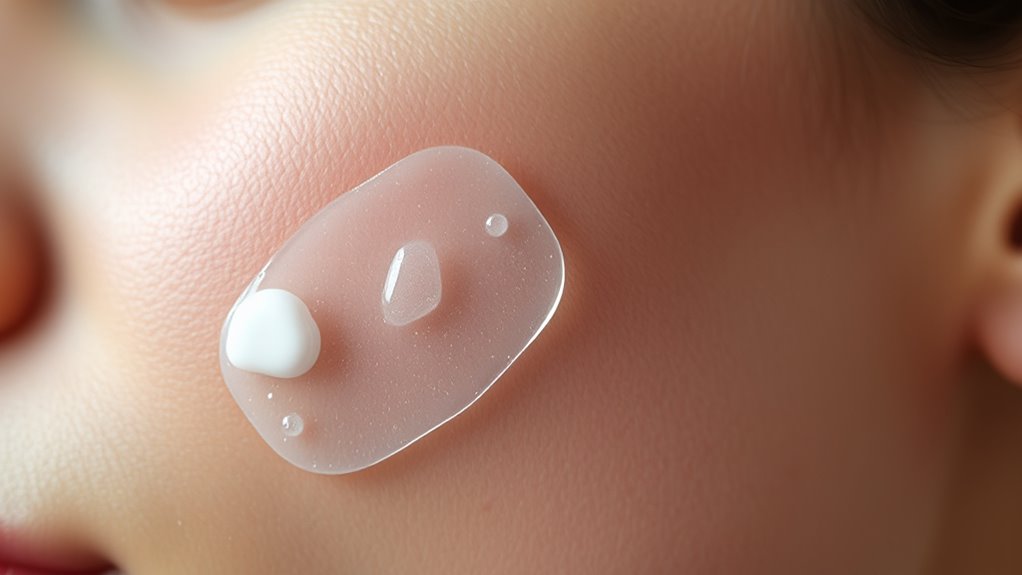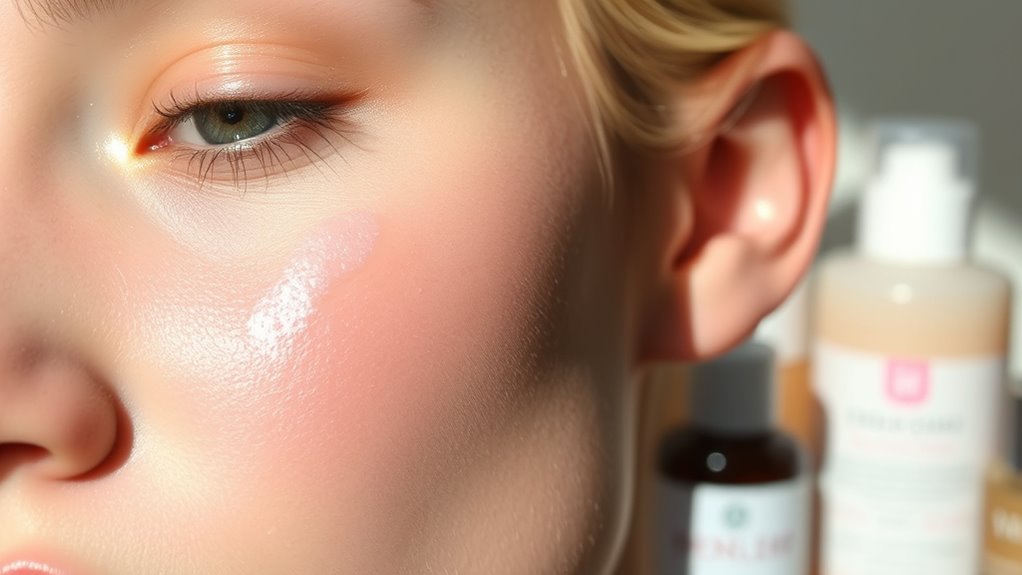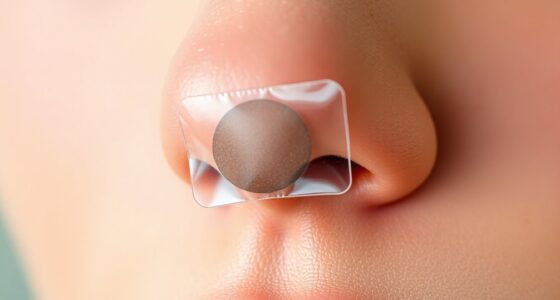You should keep your pimple patch on for 6 to 12 hours for ideal results, and they can even be left overnight for stubborn blemishes. Some may extend wear up to 24 hours for severe cases. Just be cautious—keeping it on too long can lead to irritation and redness. For the best outcomes, make sure your skin is clean and dry before applying. Want to discover more tips for effective use?
Key Takeaways
- Pimple patches are most effective when worn for 6 to 8 hours, preferably overnight for stubborn pimples.
- Some patches can be used for up to 24 hours in severe cases, ensuring clean, dry skin enhances adherence.
- The patch indicates effectiveness by turning opaque or white when it has absorbed enough moisture.
- Overuse may lead to skin irritation, redness, and potential allergic reactions due to prolonged occlusion.
- Consistent use can improve skin appearance and help prevent future breakouts through enhanced healing.
Understanding Pimple Patches and Their Function

When you’re dealing with breakouts, understanding how pimple patches work can be a game changer.
These patches, made from hydrocolloid, absorb moisture and form a gel-like consistency that helps treat your pimples effectively. Typically transparent or semi-transparent, they come in various sizes to fit different blemishes.
Pimple patches, made from hydrocolloid, absorb moisture and promote faster healing while fitting various blemish sizes effortlessly.
By placing a patch over a pimple, you create a protective barrier that absorbs excess oil and impurities while keeping dirt and bacteria out. This moist environment promotes faster healing and can even help prevent scarring. Additionally, these patches utilize hydrocolloid technology to create an ideal environment for the skin’s natural healing process.
Plus, with options available for both day and night, you can wear them under makeup or alone. Using pimple patches can simplify your skincare routine and boost your confidence during breakouts.
Recommended Duration for Maximum Effectiveness

To achieve the best results with pimple patches, it’s crucial to follow the recommended duration for use. Typically, you should leave them on for 4 to 8 hours, with 6 to 8 hours being ideal. For stubborn pimples, consider leaving patches on overnight to enhance effectiveness. Some patches can even stay on for up to 24 hours for severe cases, allowing for more extensive impurity absorption. This is because hydrocolloid technology creates a protective barrier that helps absorb excess oil and draw out impurities. Make sure the patch adheres well to clean, dry skin for maximum results. You’ll notice it’s time to remove the patch when it turns opaque or white, signaling it has absorbed as much as possible. Consistent and proper usage can greatly improve your skin’s appearance and support healing.
What Happens If You Keep It On Too Long?

Keeping a pimple patch on longer than recommended can lead to various skin issues that may hinder your healing process.
You might notice increased redness or irritation in the area, along with potential skin peeling. Extended wear could also cause itching due to sensitivity to the patch’s adhesive. Additionally, the patch traps moisture, leading to dryness and a damp environment that can prolong inflammation and slow recovery. This excessive occlusion might even worsen your acne by trapping bacteria and sebum. Furthermore, pimple patches primarily address surface-level issues, which means they may not effectively treat deeper cystic acne.
There’s also a risk of allergic reactions, which can cause hives or swelling.
Ultimately, keeping the patch on for too long can delay healing and create new lesions, so it’s best to stick to the recommended duration.
Types of Acne That Benefit From Pimple Patches

Pimple patches can be highly effective for certain types of acne, especially those that are inflamed and surface-level. If you’re dealing with papules and pustules, these patches work wonders by absorbing excess fluid and reducing irritation. They’re perfect for those angry red bumps and pus-filled spots, providing both protection and a moist healing environment. Additionally, these patches create a moist environment that promotes skin healing, which is crucial for recovery. Surface-level pimples also benefit greatly, as hydrocolloid patches help speed up healing. However, don’t rely on patches for blackheads and whiteheads, as they’re not designed for closed comedones. For the best results, consider using medicated patches that contain ingredients like salicylic acid for added effectiveness. Embrace the convenience of pimple patches, and watch your skin heal more quickly!
Application Tips for Optimal Results

After identifying the types of acne that respond well to pimple patches, it’s important to guarantee you’re applying them correctly for the best results.
Start by gently cleansing your skin to remove dirt and makeup, then pat it dry with a clean towel. Confirm your hands are clean when applying the patch and avoid placing it on open wounds or freshly popped pimples.
Gently cleanse your skin and ensure your hands are clean before applying the patch to avoid irritation.
Choose the right patch based on your acne type, ensuring it covers the entire pimple. Place it directly onto the clean, dry area and press for a few seconds to secure adhesion. Pimple patches are designed for targeted treatment, making them a convenient option for individual breakouts.
Aim to leave it on for at least 6 hours, replacing it when it turns opaque. Finally, cleanse the area gently after removal to maintain skin health.
Safety Considerations for Sensitive Skin

When using pimple patches on sensitive skin, it’s crucial to be mindful of potential irritation and adverse reactions. Hydrocolloid patches can sometimes cause dryness or irritation, so opt for products specifically designed for sensitive skin, like those from Neutrogena. Additionally, pimple patches are typically made of hydrocolloid, which helps absorb fluids and promotes faster healing. If you’re considering salicylic acid patches, be cautious as they might irritate your skin further. Start with shorter wear times of 4-6 hours to gauge your skin’s reaction. Choose patches with silicone or hydrogel adhesives, as they’re less likely to cause irritation. Always assess your skin before using any patch, and if you experience severe irritation, discontinue use immediately and consult a dermatologist for alternative treatments better suited for your sensitive skin.
The Science Behind Hydrocolloid Technology

Hydrocolloid technology plays an essential role in the effectiveness of pimple patches, as it combines a gel-like inner layer with a protective outer layer. This inner layer absorbs excess fluid, pus, and impurities from your pimples, creating a moist environment that speeds up healing. Meanwhile, the outer layer acts as a barrier against external irritants like dirt and bacteria, preventing you from picking at the blemish, which can lead to scarring. Originally used in wound care, hydrocolloid technology has gained popularity for treating acne due to its ability to absorb oil and bacteria and promote healing.
Enhancing Your Skincare Routine With Pimple Patches

To enhance your skincare routine, incorporating pimple patches can be a game changer for managing breakouts effectively.
These patches create a protective barrier that speeds up blemish healing while reducing inflammation and redness. They also safeguard your skin from irritants, keeping pollution and bacteria at bay. With ingredients like salicylic acid and tea tree oil, pimple patches tackle various types of acne, making them versatile for daily use. You can wear transparent patches under makeup, allowing you to maintain your routine without compromising appearance. Just verify your skin is clean and dry before applying, and leave the patch on for 6-12 hours for peak results. Consistent use can help prevent future breakouts too! Additionally, the occlusive nature of these patches softens the top layer of skin, enhancing ingredient penetration for better results. Furthermore, using patches made with hydrocolloid technology can significantly improve healing time and effectiveness. To maximize efficacy, it’s best to choose patches specifically designed for cystic acne treatment, as they are formulated to absorb impurities effectively.
Frequently Asked Questions
Can I Use Pimple Patches on Other Skin Issues?
Yes, you can use pimple patches on other skin issues, but they’re primarily designed for whiteheads.
They work best on inflamed spots, offering a barrier to prevent touching and irritation.
However, they won’t prevent new breakouts or treat deeper acne types.
If your skin is irritated or broken, it’s best to avoid them.
For ideal results, combine patches with other treatments like benzoyl peroxide or salicylic acid in your skincare routine.
Do Pimple Patches Work for All Skin Types?
Think of pimple patches like a trusty umbrella on a rainy day—they work for everyone, but the effectiveness can vary.
Yes, these patches suit all skin types, from oily to dry. If you’ve got sensitive skin, just choose gentle options.
They’re particularly beneficial if you’re prone to breakouts, offering a protective layer while absorbing fluids.
How Do I Know When to Replace the Patch?
You know it’s time to replace the pimple patch when it turns opaque or white, indicating it’s absorbed impurities.
If you notice the edges lifting or the patch peeling off, swap it out immediately to keep it effective.
Swelling or redness around the patch also signals that it’s reached its limit.
Regularly check the patch to verify it’s still doing its job, and don’t hesitate to change it when needed.
Can I Apply Makeup Over Pimple Patches?
You’d think wearing a pimple patch means saying goodbye to makeup, but surprise! You can actually apply makeup over it.
Just make sure to use a light touch and thin layers, so you don’t disturb the patch. Lightweight foundation and matte concealer work wonders, creating a smooth canvas.
Plus, it helps keep your blemish under wraps while it heals. So go ahead, blend gently, and let your skin breathe while looking flawless!
Are There Any Side Effects of Using Pimple Patches?
Yes, there are side effects of using pimple patches. You might experience redness and irritation, especially if you have sensitive skin.
If you apply them over unclean pimples, bacteria can get trapped beneath the patch. Prolonged use may lead to dryness or even blisters.
It’s important to keep your skin clean before applying patches and to monitor for any adverse reactions. Using hydrating moisturizers can help counteract dryness.
Conclusion
So, you thought slapping on a pimple patch meant instant results, right? Ironically, keeping it on too long can turn that miracle worker into a stubborn roommate you can’t get rid of. Aim for six to eight hours for the best results, and you’ll be saying goodbye to that pesky pimple sooner than you think. Embrace the patch life, but remember: it’s not a fashion statement, just a clever little trick in your skincare arsenal!








